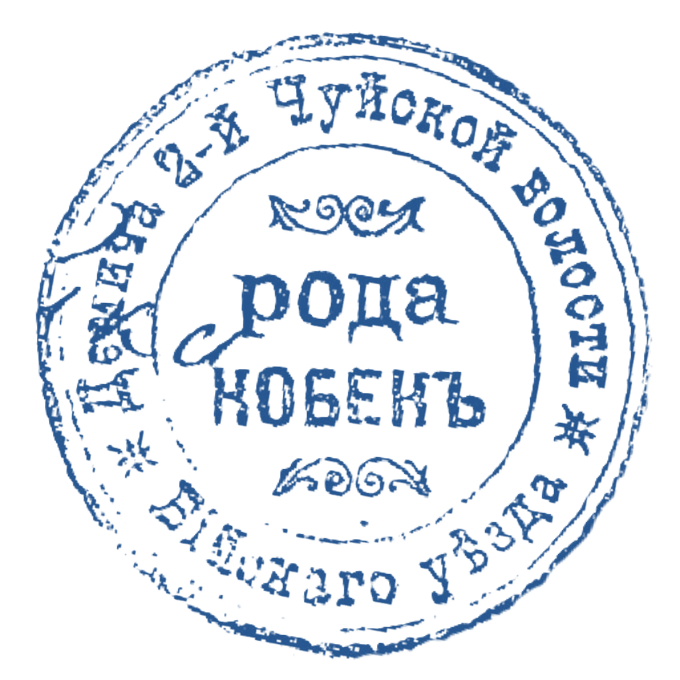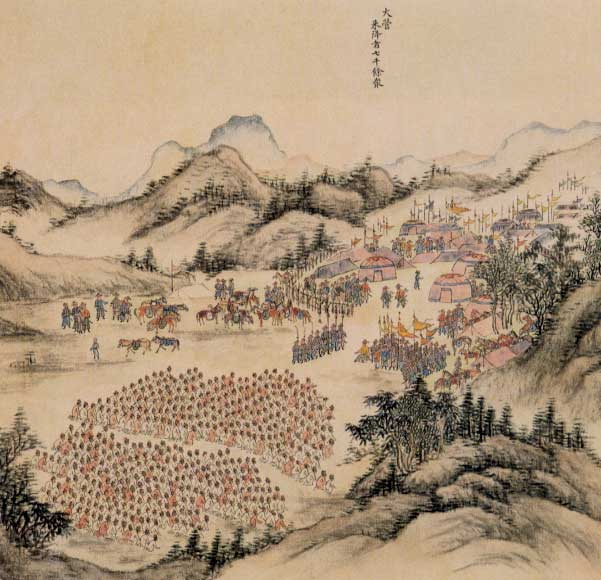|
Yarynak
Yarynak () was a Zaisan of the Second Chui Volost, as well as a Qing official of the third rank (since 1757) and a major in the Russian Empire (since 1763).. Biography Yarynak was the middle child in the family of Prince Kebegesh and Princess Ditasai. He was named after his grandfather Kayrakan-Yarynak, who was the prince of the Yenisei Kyrgyz at the end of the 17th century. Reign In 1757, when the Third Oirat-Manchurian War was in full swing and the inhabitants of the Altai Mountains were involved in the conflict, the Qing government recognized the power of Zaisan Yarynak in the Second Chui Volost, and also demanded that people exclusively from the House of Ak-Kebek rule in this otok.. Also, the Qianlong Emperor equated Yarynak with officials of the third rank in China This partial subordination to China was a forced measure, since otherwise the residents of Chui were threatened with complete destruction or forced relocation. And already at the end of 1757, Qing tax colle ... [...More Info...] [...Related Items...] OR: [Wikipedia] [Google] [Baidu] |
House Of Ak-Kebek
The House of Ak-Kebek () is an aristocratic dynasty that ruled in the Second Chui Volost, Kebeks Otok. The founder of the house was Prince Kebegesh, the son of the Kyrgyz prince :ru:Иренек, Kayrakan-Yarynak from the :ru:Хыргыс, Khirgys dynasty. History In the summer of 1687, having received an order from Galdan Boshugtu Khan, :ru:Иренек, Kayrakan-Yarynak with a detachment of 600 soldiers went to help in the fight against the Mongols. In September, near Teletskoye, Lake Teletskoye, the Mongols blocked the path of the Kyrgyz army heading for the Dzungarian Khan. The battle lasted four days, and as a result, the Dzungars and the Kyrgyz were defeated. Kyrgyz losses amounted to 300 people, and Yarynak died in battle. Butanaev, Viktor Yakovlevich, Viktor Butanaev assumed that some of the surviving Kyrgyz warriors, led by Kebegesh, joined the Altai tribes and gave rise to the Ak-Kebek dynasty At the same time, the Second Chui Volost was formed, which did not recogniz ... [...More Info...] [...Related Items...] OR: [Wikipedia] [Google] [Baidu] |
Second Chui Volost
The Second Chui Volost (Otok of Kebeks,Самаев Г. П«ГОРНЫЙ АЛТАЙ В XVII — СЕРЕДИНЕ XIX В.: ПРОБЛЕМЫ ПОЛИТИЧЕСКОЙ ИСТОРИИ И ПРИСОЕДИНЕНИЯ К РОССИИ». Page 169. Altan Nuur UrianghaiДвоеданничество в Сибири. XVII — 60-е гг. XIX вв. / О. В. Боронин; Алт. гос. ун-т. Каф. востоковедения, Алт. центр востоковед. исслед. ... [...More Info...] [...Related Items...] OR: [Wikipedia] [Google] [Baidu] |
Zaisan (title)
Zaisan () is an ancient title among the Mongols, Buryats, Kalmyks, Altaians, Khakas, Telengits, denoting the hereditary ruler of the otok, ulus or aimag. In some cases, the title corresponded to the prince.Чихачев П. А. Путешествие в Восточный Алтай / перевод с фр., предисл. и коммент. В. В. Цыбульского. М.: �аука,Гл. ред вост. лит., 1974.- 360 с. (Центральная Азия в источниках и материалах XIX- начала XXвека). Page. 88.Аристов Н.А. Заметки об этническом составе тюркских племен и народностей... Page. 341. Etymology The word "zaisan" comes from the name of the Chinese title " zaixiang", which served as chancellor. The title of zaisan among Telengits In the XVIII and XIX centuries, the title of the ruler of the Teles and Kebeks Otoks, which corresponded to prince. Zaisan's power w ... [...More Info...] [...Related Items...] OR: [Wikipedia] [Google] [Baidu] |
Qing Empire
The Qing dynasty ( ), officially the Great Qing, was a Manchu-led Dynasties of China, imperial dynasty of China and an early modern empire in East Asia. The last imperial dynasty in Chinese history, the Qing dynasty was preceded by the Ming dynasty and succeeded by the Republic of China (1912–1949), Republic of China. At its height of power, the empire stretched from the Sea of Japan in the east to the Pamir Mountains in the west, and from the Mongolian Plateau in the north to the South China Sea in the south. Originally emerging from the Later Jin (1616–1636), Later Jin dynasty founded in 1616 and proclaimed in Shenyang in 1636, the dynasty seized control of the Ming capital Beijing and North China in 1644, traditionally considered the start of the dynasty's rule. The dynasty lasted until the Xinhai Revolution of October 1911 led to the abdication of the last emperor in February 1912. The multi-ethnic Qing dynasty Legacy of the Qing dynasty, assembled the territoria ... [...More Info...] [...Related Items...] OR: [Wikipedia] [Google] [Baidu] |
Yenisei Kyrgyz
The Yenisei Kyrgyz () were an ancient Turkic people who dwelled along the upper Yenisei River in the southern portion of the Minusinsk Depression from the 3rd century BCE to the 13th century CE. The heart of their homeland was the forested Tannu-Ola mountain range (known in ancient times as the Lao or Kogmen mountains), in modern-day Tuva, just north of Mongolia. The Sayan Mountains were also included in their territory at different times. The Yenisei Kyrgyz Khaganate existed from 538 to 1219 CE; in 840, it took over the leadership of the Turkic Khaganate from the Uyghurs, expanding the state from the Yenisei territories into Central Asia and the Tarim Basin. History The Yenisei Kyrgyz correlated with the and may perhaps be correlated to the Tashtyk culture. Their endonym was variously transcribed in Chinese historical texts as ''Jiegu'' (結骨), ''Hegu'' (紇骨), ''Hegusi'' (紇扢斯), ''Hejiasi'' (紇戛斯), ''Hugu'' (護骨), ''Qigu'' (契骨), ''Juwu'' (居勿), a ... [...More Info...] [...Related Items...] OR: [Wikipedia] [Google] [Baidu] |
Dzungar–Qing Wars
The Dzungar–Qing Wars (, ) were a decades-long series of conflicts that pitted the Dzungar Khanate against the Qing dynasty and its Mongol vassals. Fighting took place over a wide swath of Inner Asia, from present-day central and eastern Mongolia to Tibet, Qinghai, and Xinjiang regions of present-day China. Qing victories ultimately led to the incorporation of Outer Mongolia, Tibet and Xinjiang into the Qing Empire that was to last until the 1911 Revolution, fall of the dynasty in 1911–1912, and the Dzungar genocide, genocide of much of the Dzungar population in the conquered areas. Background After the collapse of the Yuan dynasty in 1368, China's Mongol rulers withdrew to Mongolia and became known as the Northern Yuan. Over time, the Mongol state disintegrated into a series of Khanates, ruled by various descendants of Genghis Khan. The Qing dynasty defeated the Inner Chahars, Chahar Mongol leader Ligdan Khan and annexed Inner Mongolia. While the Eastern Mongols (Outer a ... [...More Info...] [...Related Items...] OR: [Wikipedia] [Google] [Baidu] |
Qianlong Emperor
The Qianlong Emperor (25 September 17117 February 1799), also known by his temple name Emperor Gaozong of Qing, personal name Hongli, was the fifth Emperor of China, emperor of the Qing dynasty and the fourth Qing emperor to rule over China proper. He reigned officially from 1735 until his abdication in 1796, but retained ultimate power subsequently until his death in 1799, making him one of the longest-reigning monarchs in history as well as one of the longest-lived. The fourth and favourite son of the Yongzheng Emperor, Qianlong ascended the throne in 1735. A highly ambitious military leader, he led Ten Great Campaigns, a series of campaigns into Inner Asia, Burma, Nepal and Vietnam and suppressed rebellions in Jinchuan County, Jinchuan and Taiwan. During his lifetime, he was given the deified title Emperor Manjushri by the Qing's Tibetan subjects. Domestically, Qianlong was a major patron of the arts as well as a prolific writer. He sponsored the compilation of the ''Siku Qu ... [...More Info...] [...Related Items...] OR: [Wikipedia] [Google] [Baidu] |
Dzungar Khanate
The Dzungar Khanate ( Mongolian: ), also known as the Zunghar Khanate or Junggar Khanate, was an Inner Asian khanate of Oirat Mongol origin. At its greatest extent, it covered an area from southern Siberia in the north to present-day Kyrgyzstan in the south, and from present-day west of Mongolia and the Great Wall of China in the east to present-day Kazakhstan in the west. The core of the Dzungar Khanate is today part of northern Xinjiang, also called Dzungaria. About 1620 the western Mongols, known as the Oirats, united in the Junggar Basin in Dzungaria. In 1678, Galdan received from the Dalai Lama the title of ''Boshogtu Khan'', making the Dzungars the leading tribe within the Oirats. The Dzungar rulers used the title of Khong Tayiji, which translates into English as "crown prince". Between 1680 and 1688, the Dzungars conquered the Tarim Basin, which is now southern Xinjiang, and defeated the Khalkha Mongols to the east. In 1696, Galdan was defeated by the Qing dy ... [...More Info...] [...Related Items...] OR: [Wikipedia] [Google] [Baidu] |
Telengits
Telengits or Telengut () are a Turkic ethnic group native to Central Asia that are recognized as one of the minor indigenous peoples of Russia. They mainly live in the Kosh-Agachsky District of the federal Altai Republic. History Chinese chroniclers might have mentioned Telengits as Middle Chinese: *, ( Standard Mandarin Chinese: ). During Dzungar domination, the Telengits had to pay a fur tribute or yasak to the Dzungars. The Telengits in the 14th century created their own principality (the ''Ulus'' or ''Orda''). This principality was known in Russian documents of the 16th−18th century as the ' (; ) and is termed by modern historians the "Telengit Ulus". The Telengit princes, titled ''Biy'', for a long time retained independence, and later had only a formal dependence between the states (Russia and the Dzungar Khanate); Telengits even inflicted defeats on both, until they were finally conquered by the Dzungar Khanate in the 18th century. They then became part of the ... [...More Info...] [...Related Items...] OR: [Wikipedia] [Google] [Baidu] |
Russian Empire
The Russian Empire was an empire that spanned most of northern Eurasia from its establishment in November 1721 until the proclamation of the Russian Republic in September 1917. At its height in the late 19th century, it covered about , roughly one-sixth of the world's landmass, making it the list of largest empires, third-largest empire in history, behind only the British Empire, British and Mongol Empire, Mongol empires. It also Russian colonization of North America, colonized Alaska between 1799 and 1867. The empire's 1897 census, the only one it conducted, found a population of 125.6 million with considerable ethnic, linguistic, religious, and socioeconomic diversity. From the 10th to 17th centuries, the Russians had been ruled by a noble class known as the boyars, above whom was the tsar, an absolute monarch. The groundwork of the Russian Empire was laid by Ivan III (), who greatly expanded his domain, established a centralized Russian national state, and secured inde ... [...More Info...] [...Related Items...] OR: [Wikipedia] [Google] [Baidu] |
Catherine II
Catherine II. (born Princess Sophie of Anhalt-Zerbst; 2 May 172917 November 1796), most commonly known as Catherine the Great, was the reigning empress of Russia from 1762 to 1796. She came to power after overthrowing her husband, Peter III of Russia, Peter III. Under her long reign, inspired by the ideas of the Age of Enlightenment, Enlightenment, Russia experienced a renaissance of culture and sciences, which led to the founding of many new cities, universities, and theatres, along with large-scale immigration from the rest of Europe and the recognition of Russia as one of the great powers of Europe. In her accession to power and her rule of the empire, Catherine often relied on her noble favourites, most notably Count Grigory Orlov and Grigory Potemkin. Assisted by highly successful List of Russian field marshals, generals such as Alexander Suvorov and Pyotr Rumyantsev, and List of Russian admirals, admirals such as Samuel Greig and Fyodor Ushakov, she governed at a time ... [...More Info...] [...Related Items...] OR: [Wikipedia] [Google] [Baidu] |





